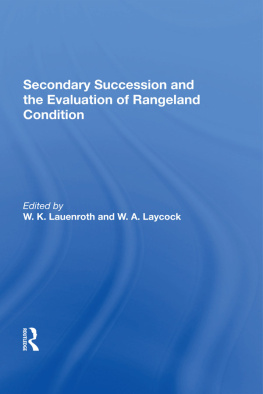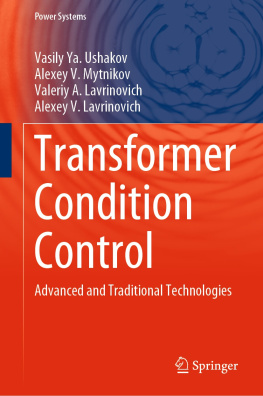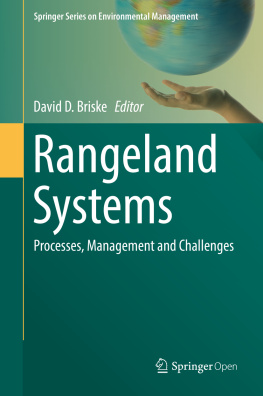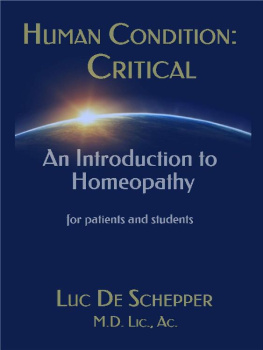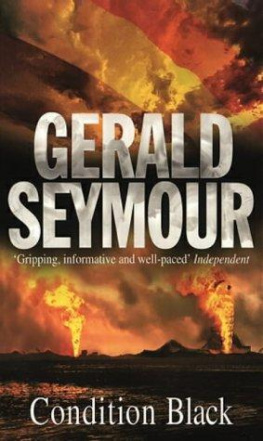Secondary Succession and the Evaluation of Rangeland Condition
First published 1989 by Westview Press
Published 2019 by Routledge
52 Vanderbilt Avenue, New York, NY 10017
2 Park Square, Milton Park, Abingdon, Oxon OX14 4RN
Routledge is an imprint of the Taylor & Francis Group, an informa business
Copyright 1989 Taylor & Francis
All rights reserved. No part of this book may be reprinted or reproduced or utilised in any form or by any electronic, mechanical, or other means, now known or hereafter invented, including photocopying and recording, or in any information storage or retrieval system, without permission in writing from the publishers.
Notice:
Product or corporate names may be trademarks or registered trademarks, and are used only for identification and explanation without intent to infringe.
Library of Congress Cataloging-in-Publication Data
Secondary succession and the evaluation of rangeland condition /
edited by W. K. Lauenroth and W. A. Laycock.
p. cm. -- (Westview special studies in agriculture science
and policy)
Includes index.
1. Rangelands--Evaluation. 2. Range management. I. Lauenroth,
William K. II. Laycock, William A., 1930- .III. Series.
SF85.6.E82S43 1989
333.74--dc20
89-32687
CIP
ISBN 13: 978-0-367-28686-6
Contents
, W. A. Laycock
, Donald T. Pendleton
, R. E. Wagner
, W. H. Moir
, A. D. Wilson
, E. Lamar Smith
, Paul G. Risser
Guide
The concept of range condition has undergone development for 65 years since it was initiated by A. W. Sampson. The first 30 years represented a period of development and refinement of concepts and field methods. The next 25 years were characterized by application to a wide variety of rangelands in the United States and elsewhere. It was during this time that federal agencies in the United States formalized approaches to the evaluation of range condition and trend. The past decade has been a period of reflection and analysis during which many range professionals have begun to question established concepts of rangeland condition and investigate alternative approaches. The purpose of this book is to juxtapose traditional and currently applied concepts of rangeland condition with new concepts.
The objective is to initiate a dialogue between traditionalists and their critics. Our plan to reach this objective is to address three general questions about rangeland condition concepts :
- What are the current concepts being used by land management?
- How well are current concepts serving the needs of management organizations?
- What alternatives should we explore for future concepts of rangeland condition?
The first step in any problem-solving exercise provides a summary of the current and new ideas proposed in previous chapters and goes a step further by suggesting new ideas from ecology that may have value for the future development of the concepts used in rangeland management.
The book is the product of a great deal of hard work on the parts of a number of individuals. Barbara Berg was untiring in the pursuit of the details of producing the book. Support for this effort was provided by the U.S. Department of Agriculture Agricultural Research Service, the National Science Foundation-sponsored Long Term Ecological Research project at Colorado State University (BSR 8114822), and the Colorado State University Agricultural Experiment Station.
W. K. Lauenroth
W. A. Lavcock
W. K. Lauenroth Range Science Department and Natural Resource Ecology Laboratory, Colorado State University, Fort Collins, CO 80523
W. A. Laycock Department of Range Management, University of Wyoming, Laramie, WY 82071
W. H. Moir, U.S. Forest Service, Rocky Mountain Forest and Range Experiment Station, Fort Collins, CO 80526
Donald T. Pendleton, National Range Conservationist, Soil Conservation Service (now retired), P. O. Box 86, Caddo, TX 76029
Paul G. Risser, Vice-President for Research, University of New Mexico, Albuquerque, NM 87131
E. Lamar Smith, School of Renewable Natural Resources, University of Arizona, Tucson, AZ 85721
R. E. Wagner, Division of Resource Systems, Bureau of Land Management, Denver Service Center, Denver, CO 80225
A. D. Wilson, CSIRO, Division of Wildlife and Rangelands Research, Private Mail Bag, Deniliquin, N.S.W. 2710, Australia
1
Secondary Succession and Range Condition Criteria: Introduction to the Problem
W. A. Laycock
Introduction
The need to determine current condition of rangeland as a basis for management decisions has long been recognized. Formulation of concepts to evaluate range condition, techniques to detect changes in condition, and management strategies to ensure the long-term productivity of the range resource are some of the major challenges facing rangeland managers. These concerns are clearly pointed out in the next 3 chapters describing the history and current procedures for determining range condition in the Soil Conservation Service ().
The procedures to determine range condition currently used in the United States were developed 40 years ago and were based on ecological principles developed in the 2530 years prior to that time. Moir () claim that the theories and practices concerning range condition have not kept pace with ecological thought or new theory and that changes are needed in the way range condition criteria are formulated.
Expressions of the current condition of any rangeland must be based on a defined standard. The usual way to express range condition is to describe the present vegetation as a proportion of the potential production or species composition for that site. The form or definition of the standard is a part of the controversy. Current range condition classification procedures usually indicate that the standard should be the highest ecological state that the site can attain, i.e., climax. Critics argue that, without sacrificing site stability or degrading site potential, other goals or standards would be more meaningful to managers. Examples of such standards might be maximum forage for livestock, maximum cover, habitat for specific kinds of wildlife, or maximum soil protection for watershed values. Moir () describes a method for determining livestock forage condition used by the Forest Service based on forage production and species composition.
As a basis for discussion, some definitions of terms from the glossary published by the Society for Range Management (SRM) (1974) are presented below.
Range Condition : The current productivity of a range relative to what that range is naturally capable of producing.
Range Condition Class : One of a series of arbitrary categories used to classify range condition and usually expressed as either excellent, good, fair or poor.
Range Condition Trend : The direction of change in range condition. Syn., range trend and trend in range condition .
These definitions may be a significant part of the problem and they are being redefined in a revision of the SRM Glossary now in preparation. Definitions for both Range Condition Class and Range Condition Trend depend upon the rather vague definition for Range Condition. An important problem is the dual meaning for range condition. Farm and ranch reporters often use the term to mean the state of the range at a particular time, especially as related to precipitation or growing conditions. Thus a farm reporter on the radio or in a newspaper may say something such as, because of favorable precipitation this spring, range conditions in the state are good.

